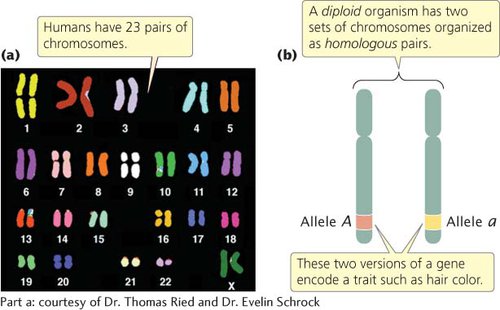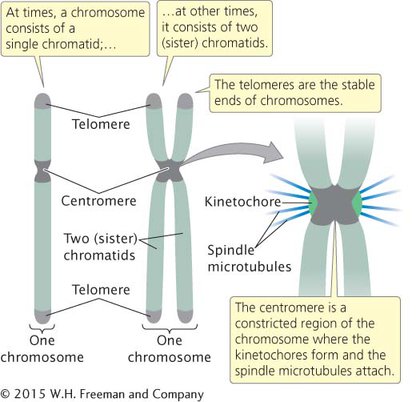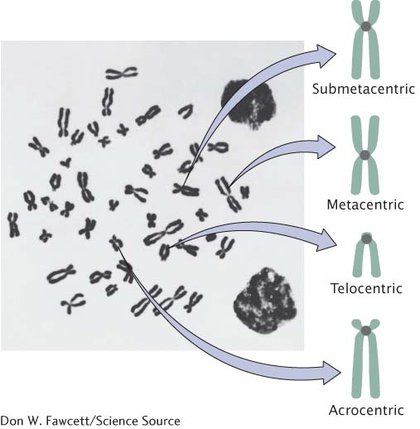Eukaryotic Cell Reproduction
Like prokaryotic cell reproduction, eukaryotic cell reproduction requires the processes of DNA replication, copy separation, and division of the cytoplasm. However, the presence of multiple DNA molecules requires a more complex mechanism to ensure that exactly one copy of each molecule ends up in each of the new cells.
EUKARYOTIC CHROMOSOMES Eukaryotic chromosomes are separated from the cytoplasm by the nuclear envelope. The nucleus has a highly organized internal scaffolding, called the nuclear matrix, that consists of a network of protein fibers. The nuclear matrix maintains precise spatial relations among the components of the nucleus and takes part in DNA replication, the expression of genes, and the modification of gene products before they leave the nucleus.
Each eukaryotic species has a characteristic number of chromosomes per cell: potatoes have 48 chromosomes, fruit flies have 8, and humans have 46. There appears to be no special relation between the complexity of an organism and its number of chromosomes per cell. In most eukaryotic cells, there are two sets of chromosomes. The presence of two sets is a consequence of sexual reproduction: one set is inherited from the male parent and the other from the female parent. Each chromosome in one set has a corresponding chromosome in the other set; together, the two chromosomes constitute a homologous pair (Figure 2.5). Human cells, for example, have 46 chromosomes, constituting 23 homologous pairs.

The two chromosomes of a homologous pair are usually alike in structure and size, and each carries genetic information for the same set of hereditary characteristics (the sex chromosomes are an exception and will be discussed in Chapter 4). For example, if a gene on a particular chromosome encodes a characteristic such as hair color, another copy of the gene (each copy is called an allele) at the same position on that chromosome’s homolog also encodes hair color. However, these two alleles do not need to be identical: one of them might encode brown hair and the other might encode blond hair.
Cells that carry two sets of genetic information are diploid. In general, the ploidy of the cell indicates how many sets of genetic information the cell possesses. Reproductive cells (such as eggs, sperm, and spores), and even nonreproductive cells in some eukaryotic organisms, contain a single set of chromosomes and are haploid. The cells of some organisms contain more than two sets of genetic information and are polyploid (see Chapter 6).
CONCEPTS
Cells reproduce by copying and separating their genetic information and then dividing. Because eukaryotic cells possess multiple chromosomes, mechanisms exist to ensure that each new cell receives one copy of each chromosome. Most eukaryotic cells are diploid, and their two chromosome sets can be arranged in homologous pairs. Haploid cells contain a single set of chromosomes.
 CONCEPT CHECK 2
CONCEPT CHECK 2
Diploid cells have
two chromosomes.
two sets of chromosomes.
one set of chromosomes.
two pairs of homologous chromosomes.
b
CHROMOSOME STRUCTURE The chromosomes of eukaryotic cells are larger and more complex than those found in prokaryotes, but each unreplicated chromosome nevertheless consists of a single molecule of DNA. Although linear, the DNA molecules in eukaryotic chromosomes are highly folded and condensed; if stretched out, some human chromosomes would be several centimeters long—
A functional chromosome has three essential elements: a centromere, a pair of telomeres, and origins of replication. The centromere is the attachment point for spindle microtubules, which are the filaments responsible for moving chromosomes during cell division (Figure 2.6). The centromere appears as a constricted region of the chromosome. Before cell division, a multiprotein complex called the kinetochore assembles on the centromere; later, spindle microtubules attach to the kinetochore. Chromosomes lacking a centromere cannot be drawn into the newly formed nuclei; these chromosomes are lost, often with catastrophic consequences for the cell. On the basis of the location of the centromere, chromosomes are classified into four types: metacentric, submetacentric, acrocentric, and telocentric (Figure 2.7).


Telomeres are the natural ends, or tips, of a linear chromosome (see Figure 2.6). Like the plastic tips on the ends of a shoelace, telomeres protect and stabilize the chromosome ends. If a chromosome breaks, producing new ends, these ends have a tendency to stick together, and the chromosome is degraded at the newly broken ends. Telomeres provide chromosome stability. Research shows that telomeres also participate in limiting cell division and may play important roles in aging and cancer (as we will see in Chapter 9).
Origins of replication are the sites where DNA synthesis begins; they are not easily observed by microscopy. There are multiple origins of replication on each eukaryotic chromosome. In preparation for cell division, each chromosome replicates, making a copy of itself, as already mentioned. These two initially identical copies, called sister chromatids, are held together at the centromere (see Figure 2.6). Each sister chromatid consists of a single molecule of DNA.
CONCEPTS
Sister chromatids are copies of a chromosome held together at the centromere. Functional chromosomes contain centromeres, telomeres, and origins of replication. The kinetochore is the point of attachment for the spindle microtubules. Telomeres are the stabilizing ends of a chromosome. Origins of replication are sites where DNA synthesis begins.
 CONCEPT CHECK 3
CONCEPT CHECK 3
What would be the result if a chromosome did not have a kinetochore?
The kinetochore is the point at which spindle microtubules attach to the chromosome. If the kinetochore were missing, spindle microtubules would not attach to the chromosome, the chromosome would not be drawn into the newly formed nuclei, and the resulting cells would be missing a chromosome.